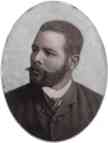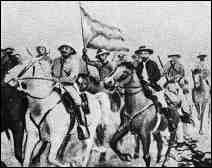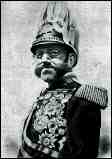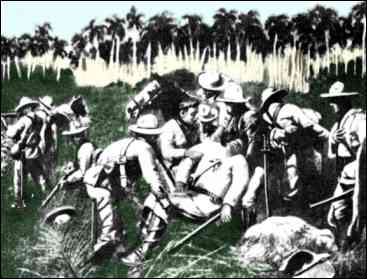



February 24. With the "Cry of Baire," (Grito de Baire) Revolution breaks out again. (Baire is a village about 50 miles from Santiago de Cuba.) Historian Philip S. Foner, in The Spanish-Cuban-American War, Vol. 1, writes: "According to all standard works by military analysts, the prospects for the insurgents did not appear bright. The Spanish army already in the island was superior in number, equipment, training, and in almost every essential of warfare. Moreover, a steady stream of reinforcements could be dispatched to Cuba, and the insurgents had no navy to prevent their reaching the scene of conflict."
February 27. Gómez writes to Maceo: "The smoke of gunfire is visible in Cuba, and the blood of our comrades is being shed on its soil. We have no other choice than to leave from wherever and however we can."
March 25. On his last day in Costa Rica, Maceo writes to his wife: "I have experienced untold bitterness, disgust, and displeasure brought on by those who shelter avarice in their hearts, disguised by the polish of goodness. Now often men with a poor sense of loyalty deceive their friends!"
March 28. On his way to Cuba on the ship Adirondack, Maceo arrives in Kingston.
March 30. Antonio and José Maceo land in eastern Cuba (from Santo Domingo). The ship is destroyed during the landing on the beach near Baracoa. The rebels are greeted with joy by the farmers cry “Maceo is here! Viva Cuba Libre!”
April 2-10. As the rebels make their way to the rebel camp, one of
the guides slips away at Dos Brazos and betrays the group, informing Spaniards
of the rebels' location and numbers.
Flor Crombet is killed in
battle in La Alegría.
April 11. José Martí and Máximo Gómez land in eastern Cuba from Costa Rica.
April 12. After being attacked at Loma Colorado, Maceo learns of Flor Crombet's death. [Of the 23 men who landed with Maceo, only 13 are still alive.]
April 20. A communiqué to all the rebel forces in Oriente announces that General Maceo is in Cuba and has assumed command of the forces on the province.
April 21. Maceo orders all rebel officers “to hang every emissary of the Spanish government, Peninsular or Cuban, whatever may be his rank, who presents himself in our camps with propositions of peace. This order must be carried out without hesitation of any kind or without attention to any contrary indications. Our motto is to triumph or die.”
April 30. Maceo writes to his wife;
“I have 6,000 men,
well-armed, and with much artillery. By the 15th of the month, I
will have 12,000 armed men, and much territory conquered.
Three days ago
Jose (Maceo) told me of the arrival of Gómez, Martí, Borrero,
Guerra and two others on the beaches between Guantánamo and
Baracoa.”
May 5. In La Mejorana, Martí, Gómez and Maceo meet to decide on the war strategy. Martí is elected as supreme leader of the revolution abroad and in nonmilitary matters. The issue of civil versus military control of the war remains unsettled; Maceo points out that dissension, petty rivalries and incompetence of the civil government during the Ten Year War had contributed to the ultimate collapse of the rebellion. He also makes it clear that he would not accept any post in the government. He also makes it clear that he will not accept any post in the government, and at one point he passionately says, "First the war and its victory; afterwards the government and its law!"
May 7. After leaving the rebel meeting in La Mejorana, Maceo attacks the towns of San Luis, El Cristo, and El Caney in southern Oriente.
May 13. Maceo surprises enemy forces at Jobito.
May 19. José Martí is killed in his first appearance on the battlefield at Dos Ríos in eastern Cuba. He is 42 years old. The rebels try to recover his body, but are unable to do so.
May 23. A reporter from the New York Herald interviews Maceo, who states: "In my campaign on the northern coast I have had no action of any great importance. The enemy columns have not dared to attack me since the battle of Jobito. I march with 5,000 well-armed men. I have received various small but excellent expeditions. I have two mountain cannons with sufficient ammunition and soon I shall begin operations on a large scale." [Most of this is an exaggeration, since the men are not well-armed and there's very little ammunition. The article runs on June 7, 1895.]
June. For most of the month Maceo is involved in minor actions in Sagua de Tánamo, Aguas Claras and the zone of Las Tunas. [Many historians point out that this is the type of warfare at which Maceo excelled; constantly on the move, striking without a visible pattern with little chance for the enemy to pin him down or figure out his next move.]
June 30. Gómez instructs Maceo to begin preparing for an invasion of the Western segment of the island. It had been determined that lack of a Western invasion was one of the reasons for the failure of the Ten-Year War.
July 2. Bartolomé Masó writes Maceo to let him know that he fully agrees with Maceo on the policy for sugar producers. [Maceo's plan is to allow sugar producers to continue grinding sugar cane if they make regular contributions to the war effort and agree not to aid the Spaniards or hamper the progress of the rebellion.]
July. General Fidel Vidal Santocildes (the man who complimented Maceo in 1890) dies in battle against Maceo's troops in the battle at Paralejo.
August 3. The first issue of the rebel newspaper El Cubano Libre is published.
August. In Oriente, near Bayamo, the rebels celebrate another impressive victory. One account of the battle has it that Martínez Campos escapes alive by having himself slung in a hammock and carried on the shoulders of his men (as if wounded).
Late August. Spaniards attack José Maceo's hospital camp in Sal del Indio. Antonio Maceo arrives just in time to help defeat the attack. As the Spaniards retreat, the rebels plant two dynamite bombs on the road ahead of them, causing a number of casualties and creating panic and confusion among enemy forces.
September 6. Salvador Cisneros Betancourt (the old and aristocratic revolutionist who had been second president of the Republic of Cuba during the Ten Year War) writes to Maceo, hinting that he might offer the Negro General a high government post if Maceo supports him for President.
September 12. Maceo responds to the letter from Cisneros Betancourt; "Do not forget the nature of my temperament if it should again occur to you to speak to me of posts and destinies which I have never solicited. As you well know, I have the satisfaction of never having held a post through favor; on the contrary, I have exhibited manifest opposition to the slightest suggestion of such a thing. The humbleness of my birth kept me from placing myself at the beginning on the heights with others who were chieftains of the Revolution by birth."
September 13. In Jimaguayú, Camagüey, the Constituent Assembly, composed of delegates from Oriente, Camagüey and Las Villas, meet to organize the Republic of Cuba and its government. Máximo Gómez is named General in Chief, and Tomás Estrada Palma is named foreign representative.
The following officials are elected:
Salvador Cisneros
Betancourt – President
Bartolomé Masó –
Vice-President
Tomás Estrada Palma – Delegate Plenipotentiary
and foreign representative
Maximo Gómez – General-in-chief of
the Army
Antonio Maceo – Lieutenant-General
September 22. Maceo sends Estrada Palma a bank draft for more than $10,000 for arms and ammunitions.
October 10. In New York’s Chickering Hall, the anniversary of the “Grito de Yara” is celebrated. Manuel Sanguilly refers to Maceo as the “Bronze Titan.”

October 22. The invasion of the West begins.
October 27. Maceo’s column arrives in Pestán.
October 30. Maceo writes to Estrada Palma: "Please do your best to send us, as quickly as possible, the weapons and munitions ordered…"
November 21. Maceo writes to Manuel Sanguily in the U.S.: "We have not been very fortunate in the make-up of the new government. Again we have been the victims of the vain effort of trying to give it the democratic forms of a republic already constituted when we have the enemy in front of us, and we are not the masters of the land we walk on. As you will understand, while the war lasts, there must only be soldiers and swords in Cuba, or at least men who know how to prosecute the war and how to achieve the final redemption of our people. When this is achieved, which is the objective to which our efforts are directed, the time will then be ripe for the forming of a civil government. Such a civil government should be eminently democratic and be capable of managing the public affairs with prudence and moderation, attentive to our own peculiar political and social requirements."
November 23. The new civil government proclaims that all sugar-cane grinding is to be prohibited without exception for the remainder of the war.
November 29. Maceo's troops cross the Trocha at Morón.
November 30. In the town Lázaro López, in
Camagüey, Gómez and Maceo (known to the Spaniards
as the fox and the lion)combine their forces (totaling 2,600
men) and begin marching toward Las Villas and the west.
Gómez addresses the combined forces:
"Soldiers! The war begins now,
the tough unmerciful war. The weak will fall by the wayside; only the strong
and the intrepid will be able to stand the ordeal. In the full ranks which I
see before me death will open great gaps. The strong among us do not expect
rewards, but only suffering and work."
December 3. The main rebel force crosses the Jatibonico River into Las Villas. Gómez learns that a Spanish column is escorting a well-supplied convoy not far from Iguará, and immediately plans a surprise attack. The ambush is discovered, and the battle of Iguará develops into the type of large-scale battle that Gómez wanted to avoid. The rebels are victorious, with heavy casualties on both sides.
December 5. General Maceo issues a proclamation directed at the people of Las Villas, calling on them to put aside provincial concerns for the sake of the nation.
December 10. A fierce battle on the Manacal Heights lasts three days, with intervening nights of rest. As the rebels continue to move westward, the Spaniards followed.
December 11. The civil government agrees to exempt sugar mill operators who had agreements with Maceo from the prohibition against cane grinding.
December 13. Under heavy artillery bombardment from Spanish General Oliver, the Cubans withdraw, leaving Maceo to fight a closely pursuing enemy. By late afternoon, the Spaniards have had enough and return to their base.
December. After the battles of Iguará and Manacal Heights practically exhaust the rebels' ammunition supplies, Gómez questions whether the western invasion can continue. Maceo refuses to consider abandoning the invasion. He tells his general that the invasion must continue, even if he had to clear his way with a machete.
In the second half of the month, the rebels cross the Hanabanilla River and advance into Matanzas.
By this time, Gómez and Maceo have worked out a strategy of escape from larger forces in which several wide-ranging units are sent out from the main column to set fire to all the surrounding cane fields. "The fires," writes Foner, "served a tactical as well as strategic purpose, since the billowing clouds of smoke created great uncertainty as to the positions of the insurgents. Invariably, the tactic was successful."
December 23. At Coliseo, several of Maceo's officers are killed in battle, and Maceo's horse is shot from under him. The rebels are forced to retreat.
December 27. During the famous "false retreat" in Las Villas, four of Maceo's soldiers invade the home of the colonel of the Spanish volunteers. When one of the soldiers threatens one of the colonel's family members, he is killed. The colonel is brought before Maceo, expecting to be executed. Maceo, however, congratulated the man who had killed his soldier, and ordered the three surviving soldiers to be shot. He makes it clear that the liberating army must respect family homes.
January 1. Martínez Campos seriously misinterprets rebel movement and reports to Havana that the rebels have been blocked and sent back to the eastern segment of the island. The "Diaro de la Marina" carries this as front-page news. On the very same day, the rebel army enters Havana province, having left a wide smoking path of destruction through Matanzas.
January 6. On "Three Kings' Day," the rebels enter Vereda Nueva, and are received with cheers of "Viva Cuba Libre!" and "Viva Maceo!"

January 7. Martínez Campos resigns his post as captain general. Spain assigns General Valeriano Weyler y Nicolau (pictured at right) as his replacement.
Near the northwestern border of Havana, Gómez and Maceo hold a strategy conference. They agree to split their forces, Maceo will continue into Pínar del Rio, and Gómez will remain in Havana, with the largest portion of the forces.
January 8. Maceo's troops cross the trocha from Havana into Pínar del Rio.
January 10. Gómez issues a public circular announcing that the rebel army would respect the peaceful population and agriculture.
January 22. The ultimate goal of the western invasion is achieved. At three in the afternoon, Maceo's troops arrive in Mantua, the westernmost town on the island. The people gather on the street to see the famed rebel, and the troops form a parade to make a grand entrance, led by the newly formed cavalry of natives from the province. At official ceremonies held the following day, Maceo is offered a champagne toast, which he declines, saying, "I do not drink any kind of liquor." He is later offered a cigar from Vuelta Abajo, which he, again graciously refuses, stating, "I am sorry not to be able to please you, but I do not smoke."
February 11. General Valeriano Weyler Y Nicolau arrives in Cuba. His highest military priority is the destruction of Maceo.
February 19. Gómez and Maceo meet in Soto to discuss Weyler's policy of re-concentration.
March 5. Maceo returns to Matanzas, outmaneuvering a powerful column sent by Weyler against him.
March 10. Maceo joins Gómez at El Galeón. It is agreed that Maceo will continue moving westward, and Gómez will continue operating in the central part of the island. This is their last meeting.
March 20. In a battle at El Rubí, despite a lack of ammunition, Maceo's column forces a numerically superior opponent to retreat.
April 15. Maceo writes to his wife, assuring her that he will outwit the enemy, and that by August, Spain will see the "hopelessness of their situation."
April 18 - 26. Waiting for supplies, Maceo takes refuge in the Tapia Mountains. The Spaniards repeatedly attack this natural defense position, but are repelled each time. Learning that an expedition with war materials from the U.S. (on the ship "Competitor") Maceo outmaneuvers the enemy. At Cacarajícara, a battle against a column of nearly 1,000 soldiers, led by General Suárez Inclán, cuts down his company to 170 men. At a critical point in the battle, Rebel Colonel Juan E. Ducasse arrives with rifles, reinforcements, and 1,000 rounds of ammunition. The enemy is forced to retreat.
May 23. Maceo attacks the fortified town of Consolación del Sur, leaving it in flames.
May 25. Maceo achieves another victory, this time over the forces of General Valdés, the supreme commander of the province.
June. After learning that the U.S. and Spain are discussing the possibility of granting Cuban autonomy and not independence, Maceo writes to Perfecto Lacoste: "The (North) Americans and Spaniards can make whatever agreements they wish, but Cuba will be free in a short while and can laugh at the negotiations which do not favor its independence."
June 6. From Havana, London Times correspondent Colonel Charles E.
Akers, writes:
"With an army of 175,000 men, with materials of all kinds in
unlimited quantities, beautiful weather, little or no sickness among the
troops, in a word, with everything in his favor, General Weyler has been unable
to defeat the insurrectionists. In the province of Pinar del Río, at
some eighteen miles from the center of the Spanish lines, is encamped since
last March the rebel General Antonio Maceo with his army. here are the rebels
almost in view of 60,000 Spanish soldiers. There is no pretense of not knowing
the position of Maceo since a Spanish general indicated to me the precise point
where the insurrectionist encampment was. The frequently repeated Spanish boast
that Maceo will not be able to cross the trocha is already worn out and
useless. Undoubtedly, whenever it suits the insurrectionary leader, he will
succeed in breaking the line, and meanwhile, it is enough for him to stay where
he is and compel more than a third of the entire Spanish army to remain on the
defensive."
June 19. Weyler's forces attack Maceo at San Gabriel de Lombello.
June 24. On the fifth day of battle (at San Gabriel de Lombello), Maceo sustains his 24th battle wound when a rifle bullet breaks a bone in the lower portion of one of his legs. He is taken to the house of a rebel civilian in the Rosario Mountain range for nine days to recover.
July. Early in the month, Jose Maceo resigns his post as Commander of the Oriente province (in order to allow Calixto Garcia to take over).
July 5. José Maceo is killed at the battle of Loma del Gato.
September 18. Maceo meets the expedition of Colonel Francisco Leyete
Vidal and obtains 500,000 rounds of ammunition, one thousand rifles, two
thousand pounds of dynamite, one cannon with 100 cannon shells and three
American artillerymen. He is also joined by Máximo Gómez' young
son, Francisco (Panchito) Gómez Toro.
Foner: "The happy shouts and
vivas of the mambises over the arrival of the war material abruptly ended when
they notice General Maceo's face. He had been handed a copy of the
Boletín de Guerra of July 15 which featured the news that on July 5,
Jose Maceo had been killed in battle at Loma del Gato in Oriente. It may seem
incredible that it took so long for the news to reach Maceo. Actually, it was
an indication of the indifference of the revolutionary government to their
greatest warrior. They had simply neglected to inform Maceo. Indeed, the only
communication Maceo received from government officials during the entire
campaign in the West was not congratulations for his remarkable achievements
against the enemy, but a criticism for making a number of appointments and
conferring ranks 'without first submitting them to the Governing Council for
their approval.'" [From: "The Spanish-Cuban-American War and the Birth of U.S.
Imperialism, Vol. 1"]
September 23 - 24. In Montezuelo, Maceo defeats larger Spanish forces, suffering 68 rebel casualties.
September 25. Another victorious clash for Maceo's troops at Tumbas de Estorino.
October 1. At Ceja del Negro, Maceo's troops are trapped by three Spanish columns. After three days of fighting, the rebels are victorious, but suffer 277 casualties. Maceo is left with 200 fighting men.
October 14. De Truffin writes: "At present being better organized and well supplied with arms and ammunition, they (the rebels led by Maceo) have altered their tactics, and are offering resistance to the royal troops. Five rather serious clashes have taken place in the last few days. The bitterness with which both sides fought is an indication that the war has entered an entirely new and more active phase."

October 27. In San Cristóbal, Maceo makes his last address to his troops. He urges them to take courage and to prepare for whatever sacrifices are necessary to win independence.
October 29. In El Roble, Maceo receives a letter from Máximo Gómez requesting his urgent return to Camagüey. He learns that Gomez has been removed from his post as General-in-Chief of the revolutionary armies.
November 9. In an encounter with Weyler's forces in the valley of Tapia, Maceo looses 77 soldiers.
November 25. Maceo interviews three soldiers who claim to have knowledge of a weak spot in the Trocha, but is not satisfied with their answers.
December 4. Maceo and 17 men circle the trocha by sea, in the port of Mariel, which requires four trips of the small boat. They come within sight of a Spanish garrison. The rebels take refuge in an abandoned sugar mill in La Merced.
December 6. Still waiting for a rebel unit with horses, Maceo gives the order to begin marching toward the sugar mill Garro.
December 7. Antonio Maceo is killed in the battle of Punta Brava in Western Cuba. Also killed is Panchito Gómez Toro.
December 8. Maceo and Gómez are buried in Cacahual, in Santiago de las Vegas.
Maceo Timeline - Part 1 | Part 2 | Part 3 | Part 4
Related:
Articles about
Antonio Maceo